Preface
Outline
Book Series Overview
Acknowledgments
Errata
Chapter 1 The Simplest Lowpass Filter
1.1Introduction
1.1.1What is a Filter?
1.1.2Why learn about filters?
1.2The Simplest Lowpass Filter
1.2.1Definition of the Simplest Low-Pass
1.3Finding the Frequency Response
1.3.1Sine-Wave Analysis
1.3.2Mathematical Sine-Wave Analysis
1.3.3Amplitude Response
1.3.4Phase Response
1.4An Easier Way
1.4.1Complex Sinusoids
1.4.2Complex Amplitude
1.4.3Phasor Notation
1.4.4Complex Sinusoids as Circular Motion
1.4.5Rederiving the Frequency Response
1.5Summary
Chapter 2 Matlab Analysis of the Simplest Lowpass Filter
2.1Matlab Filter Implementation
2.2Simulated Sine-Wave Analysis in Matlab
2.3Complex Sine-Wave Analysis
2.4Practical Frequency-Response Analysis
Chapter 3 Analysis of a Digital Comb Filter
3.1Difference Equation
3.2Signal Flow Graph
3.3Software Implementation in Matlab
3.3.1Sample-Level Implementation in Matlab
3.4Software Implementation in C++
3.5Software Implementation in Faust
3.6Impulse Response
3.7Transfer Function
3.8Frequency Response
3.9Amplitude Response
3.10Phase Response
3.11Pole-Zero Analysis
3.12Alternative Realizations
3.12.1First-Order Parallel Sections
3.12.2Parallel, Real, Second-Order Sections
3.12.3Parallel Second-Order Signal Flow Graph
3.12.4Series, Real, Second-Order Sections
3.13Summary
Chapter 4 Linear Time-Invariant Digital Filters
4.1Definition of a Signal
4.2Definition of a Filter
4.3Examples of Digital Filters
4.3.1Scaling:
4.3.2Superposition:
4.3.3Real Linear Filtering of Complex Signals
4.4Time-Invariant Filters
4.5Showing Linearity and Time Invariance, or Not
4.6Nonlinear Filter Example: Dynamic Range Compressio
4.6.1Why Dynamic Range Compression is Nonlinear
4.7A Musical Time-Varying Filter Example
4.8Analysis of Nonlinear Filters
4.9Conclusions
Chapter 5 Time Domain Digital Filter Representations
5.1Difference Equation
5.2Signal Flow Graph
5.3Causal Recursive Filters
5.4Filter Order
5.5Direct-Form-I Implementation
5.6Impulse-Response Representation
5.7Filter Stability
5.8Impulse Response Example
5.9Implications of Linear-Time-Invariance
5.10Convolution Representation
5.10.1Convolution Representation Summary
5.11Finite Impulse Response Digital Filters
5.11.1FIR impulse response
5.11.2Convolution Representation of FIR Filters
5.11.3The ``Finite'' in FIR
5.11.4Causal FIR Filters
5.11.5FIR Transfer Function
5.11.6FIR Order
5.11.7FIR Software Implementations
5.12Transient Response, Steady State, and Decay
5.12.1FIR Example
5.12.2IIR Example
5.12.3Transient and Steady-State Signals
5.12.4Decay Response, Initial Conditions Response
5.12.5Complete Response
5.13Summary and Conclusions
5.14Time Domain Representation Problems
Chapter 6 Transfer Function Analysis
6.1The Z Transform
6.2Existence of the Z Transform
6.3Shift and Convolution Theorems
6.3.1Shift Theorem
6.3.2Convolution Theorem
6.4Z Transform of Convolution
6.5Z Transform of Difference Equations
6.6Factored Form
6.7Series and Parallel Transfer Functions
6.7.1Series Case
6.7.2Parallel Case
6.7.2.1Series Combination is Commutative
6.8Partial Fraction Expansion
6.8.1Example
6.8.2Complex Example
6.8.3PFE to Real, Second-Order Sections
6.8.4Inverting the Z Transform
6.8.5FIR Part of a PFE
6.8.5.1Example: The General Biquad PFE
6.8.6Alternate PFE Methods
6.8.7Repeated Poles
6.8.7.1Dealing with Repeated Poles Analytically
6.8.7.2Example
6.8.7.3Impulse Response of Repeated Poles
6.8.7.4So What's Up with Repeated Poles?
6.8.8Alternate Stability Criterion
6.8.9Summary of the Partial Fraction Expansion
6.8.10Software for Partial Fraction Expansion
6.8.10.1Example 2
6.8.10.2Polynomial Multiplication in Matlab
6.8.10.3Polynomial Division in Matlab
6.9Problems
Chapter 7 Frequency Response Analysis
7.1Frequency Response
7.2Amplitude Response
7.3Phase Response
7.4Polar Form of the Frequency Response
7.4.1Separating the Transfer Function Numerator and Den
7.5Frequency Response as a Ratio of DTFTs
7.5.1Frequency Response in Matlab
7.5.2Example LPF Frequency Response Using freqz
7.6Phase and Group Delay
7.6.1Phase Delay
7.6.2Phase Unwrapping
7.6.3Group Delay
7.6.3.1Derivation of Group Delay as Modulation Delay
7.6.4Group Delay Examples in Matlab
7.6.5Vocoder Analysis
7.6.6Numerical Computation of Group Delay
7.7Frequency Response Analysis Problems
Chapter 8 Pole-Zero Analysis
8.1Filter Order = Transfer Function Order
8.2Graphical Computation of Amplitude Response from P
8.3Graphical Phase Response Calculation
8.4Stability Revisited
8.4.1Computing Reflection Coefficients to Check Filter
8.4.2Step-Down Procedure
8.4.3Testing Filter Stability in Matlab
8.5Bandwidth of One Pole
8.6Time Constant of One Pole
8.7Unstable Poles--Unit Circle Viewpoint
8.7.1Geometric Series
8.7.2One-Pole Transfer Functions
8.8Poles and Zeros of the Cepstrum
8.9Conversion to Minimum Phase
8.10Hilbert Transform Relations
8.11Pole-Zero Analysis Problems
Chapter 9 Implementation Structures for Recursive Digital Fi
9.1The Four Direct Forms
9.1.1Direct-Form I
9.1.1.1Two's Complement Wrap-Around
9.1.2Direct Form II
9.1.2.1More about Potential Internal Overflow of DF-II
9.1.3Transposed Direct-Forms
9.1.4Numerical Robustness of TDF-II
9.2Series and Parallel Filter Sections
9.2.1Series Second-Order Sections
9.2.1.1Matlab Example
9.2.2Parallel First and/or Second-Order Sections
9.2.2.1First-Order Complex Resonators
9.2.2.2Real Second-Order Sections
9.2.2.3Implementation of Repeated Poles
9.2.3Formant Filtering Example
9.2.4Butterworth Lowpass Filter Example
9.2.5Summary of Series/Parallel Filter Sections
9.3Pole-Zero Analysis Problems
Chapter 10 Filters Preserving Phase
10.1Linear-Phase Filters (Symmetric Impulse Responses)
10.2Zero-Phase Filters (Even Impulse Responses)
10.2.1-Phase Filters
10.2.2Phase in the Stopband
10.2.3Example Zero-Phase Filter Design
10.2.4Elementary Zero-Phase Filter Examples
10.3Odd Impulse Reponses
10.4Symmetric Linear-Phase Filters
10.4.1Simple Linear-Phase Filter Examples
10.4.2Software for Linear-Phase Filter Design
10.5Antisymmetric Linear-Phase Filters
10.6Forward-Backward Filtering
10.7Phase Distortion at Passband Edges
Chapter 11 Minimum-Phase Filters
11.1Definition of Minimum Phase Filters
11.2Minimum-Phase Polynomials
11.3Maximum Phase Filters
11.3.1Example
11.4Minimum Phase Means Fastest Decay
11.5Minimum-Phase/Allpass Decomposition
11.6Is Linear Phase Really Ideal for Audio?
11.7Creating Minimum Phase Filters and Signals
Chapter 12 Conclusion
Chapter 1 Background Fundamentals
1.1 Signal Representation and Notation
1.1.1 Units
1.1.2 Sinusoids
1.1.3 Spectrum
1.2 Complex and Trigonometric Identities
1.2.1 Complex Numbers
1.2.2 The Exponential Function
1.2.3 Trigonometric Identities
1.2.3.1Trigonometric Identities, Continued
1.2.4 Half-Angle Tangent Identities
1.3 A Sum of Sinusoids at the Same Frequency is Anothe
1.3.1 Proof Using Trigonometry
1.3.2 Proof Using Complex Variables
1.3.3 Phasor Analysis: Factoring a Complex Sinusoid into
Chapter 2 Elementary Audio Digital Filters
2.1 Elementary Filter Sections
2.1.1 One-Zero
2.1.2 One-Pole
2.1.3 Two-Pole
2.1.3.1Resonator Bandwidth in Terms of Pole Radius
2.1.4 Two-Zero
2.1.5 Complex Resonator
2.1.5.1Two-Pole Partial Fraction Expansion
2.1.6 The BiQuad Section
2.1.7 Biquad Software Implementations
2.2 Allpass Filter Sections
2.2.1 The Biquad Allpass Section
2.2.2 Allpass Filter Design
2.3 DC Blocker
2.3.1 DC Blocker Frequency Response
2.3.2 DC Blocker Software Implementations
2.4 Low and High Shelving Filters
2.4.1 Exercise
2.5 Peaking Equalizers
2.6 Time-Varying Two-Pole Filters
2.6.1 Normalizing Two-Pole Filter Gain at Resonance
2.6.2 Constant Resonance Gain
2.6.3 Peak Gain Versus Resonance Gain
2.6.4 Constant Peak-Gain Resonator
2.6.5 Four-Pole Tunable Lowpass/Bandpass Filters
2.7 Elementary Filter Problems
Chapter 3 Allpass Filters
3.1 Allpass Examples
3.2 Paraunitary FiltersC.4
3.3 Multi-Input, Multi-Output (MIMO) Allpass Filters
3.3.1 Paraunitary MIMO Filters
3.3.1.1MIMO Paraconjugate
3.3.1.2MIMO Paraunitary Condition
3.3.1.3Properties of Paraunitary Systems
3.3.1.4Properties of Paraunitary Filter Banks
3.3.2 Paraunitary Filter Examples
3.4 Allpass Problems
Chapter 4 Introduction to Laplace Transform Analysis
4.1 Existence of the Laplace Transform
4.2 Analytic Continuation
4.3 Relation to the z Transform
4.4 Laplace Transform Theorems
4.4.1 Linearity
4.4.2 Differentiation
4.5 Laplace Analysis of Linear Systems
4.5.1 Moving Mass
4.5.2 Mass-Spring Oscillator Analysis
Chapter 5 Analog Filters
5.1 Example Analog Filter
5.2 Capacitors
5.2.1 Mechanical Equivalent of a Capacitor is a Spring
5.3 Inductors
5.3.1 Mechanical Equivalent of an Inductor is a Mass
5.4 RC Filter Analysis
5.4.1 Driving Point Impedance
5.4.2 Transfer Function
5.4.3 Impulse Response
5.4.4 The Continuous-Time Impulse
5.4.5 Poles and Zeros
5.5 RLC Filter Analysis
5.5.1 Driving Point Impedance
5.5.2 Transfer Function
5.5.3 Poles and Zeros
5.5.4 Impulse Response
5.6 Relating Pole Radius to Bandwidth
5.7 Quality Factor (Q)
5.7.1 Decay Time is Q Periods
5.7.2 Q as Energy Stored over Energy Dissipated
5.8 Analog Allpass Filters
5.8.1 Lossless Analog Filters
Chapter 6 Matrix Filter Representations
6.1 Introduction
6.2 General Causal Linear Filter Matrix
6.3 General LTI Filter Matrix
6.4 Cyclic Convolution Matrix
6.5 Inverse Filters
6.6 State Space Realization
6.6.1 State Space Filter Realization Example
6.7 Time Domain Filter Estimation
6.7.1 Effect of Measurement Noise
6.7.2 Matlab System Identification Example
Chapter 7 State Space Filters
7.1 Markov Parameters
7.2 Response from Initial Conditions
7.3 Complete Response
7.4 Transfer Function of a State Space Filter
7.4.1 Example State Space Filter Transfer Function
7.5 Transposition of a State Space Filter
7.6 Poles of a State Space Filter
7.7 Difference Equations to State Space
7.7.1 Converting to State-Space Form by Hand
7.7.2 Converting Signal Flow Graphs to State-Space Form
7.7.3 Controllability and Observability
7.7.4 A Short-Cut to Controller Canonical Form
7.7.5 Matlab Direct-Form to State-Space Conversion
7.7.6 State Space Simulation in Matlab
7.7.7 Other Relevant Matlab Functions
7.7.8 Matlab State-Space Filter Conversion Example
7.8 Similarity Transformations
7.9 Modal Representation
7.9.1 Diagonalizing a State-Space Model
7.9.2 Finding the Eigenvalues of A in Practice
7.9.3 Example of State-Space Diagonalization
7.9.4 Properties of the Modal Representation
7.10 Repeated Poles
7.10.1 Jordan Canonical Form
7.11 State-Space Analysis Example: The Digital Waveguid
7.11.1 Finding the Eigenstructure of A
7.11.2 Choice of Output Signal and Initial Conditions
7.12 References
7.13 State Space Problems
Chapter 8 A View of Linear Time Varying Digital Filters
8.1 Introduction
8.2 Derivation
8.3 Summary
Chapter 9 Recursive Digital Filter Design
9.1 Lowpass Filter Design
9.2 Butterworth Lowpass Design
9.2.1 Butterworth Lowpass Poles and Zeros
9.2.2 Example: Second-Order Butterworth Lowpass
9.3 Digitizing Analog Filters with the Bilinear Transf
9.3.1 Bilinear Transformation
9.3.2 Frequency Warping
9.3.3 Analog Prototype Filter
9.3.4 Examples
9.4 Filter Design by Minimizing the L2 Equation-Error
9.4.1 Equation Error Formulation
9.4.2 Error Weighting and Frequency Warping
9.4.3 Stability of Equation Error Designs
9.4.4 An FFT-Based Equation-Error Method
9.4.5 Prony's Method
9.4.6 The Padé-Prony Method
Chapter 10 Matlab Utilities
10.1 Time Plots: myplot.m
10.2 Frequency Plots: freqplot.m
10.3 Saving Plots to Disk: saveplot.m
10.4 Frequency Response Plots: plotfr.m
10.5 Partial Fraction Expansion: residuez.m
10.5.1 Method
10.5.2 Example with Repeated Poles
10.6 Partial Fraction Expansion: residued.m
10.6.1 Method
10.7 Parallel SOS to Transfer Function: psos2tf.m
10.8 Group Delay Computation: grpdelay.m
10.9 Matlab listing: fold.m
10.10 Matlab listing: clipdb.m
10.11 Matlab listing: mps.m and test program
10.11.1 Matlab listing: mps.m
10.11.2 Matlab listing: tmps.m
10.11.3 Matlab diary: tmps.d
10.12 Signal Plots: swanalplot.m
10.13 Frequency Response Plot: swanalmainplot.m
Chapter 11 Digital Filtering in Faust and PD
11.1 A Simple Faust Program
11.2 Generating Faust Block Diagrams
11.3 Testing a Faust Filter Section
11.4 A Look at the Generated C++ code
11.5 Generating a Pure Data (PD) Plugin
11.5.1 Generating the PD Plugin
11.5.2 Generating a PD Plugin-Wrapper Abstraction
11.5.3 A PD Test Patch for the Plugin Wrapper
11.6 Generating a LADSPA Plugin via Faust
11.7 Generating a VST Plugin via Faust
11.7.1 Bypassing Windows
11.8 Generating a MIDI Synthesizer for PD
11.9 MIDI Synthesizer Test Patch
Links to Online Resources
Bibliography
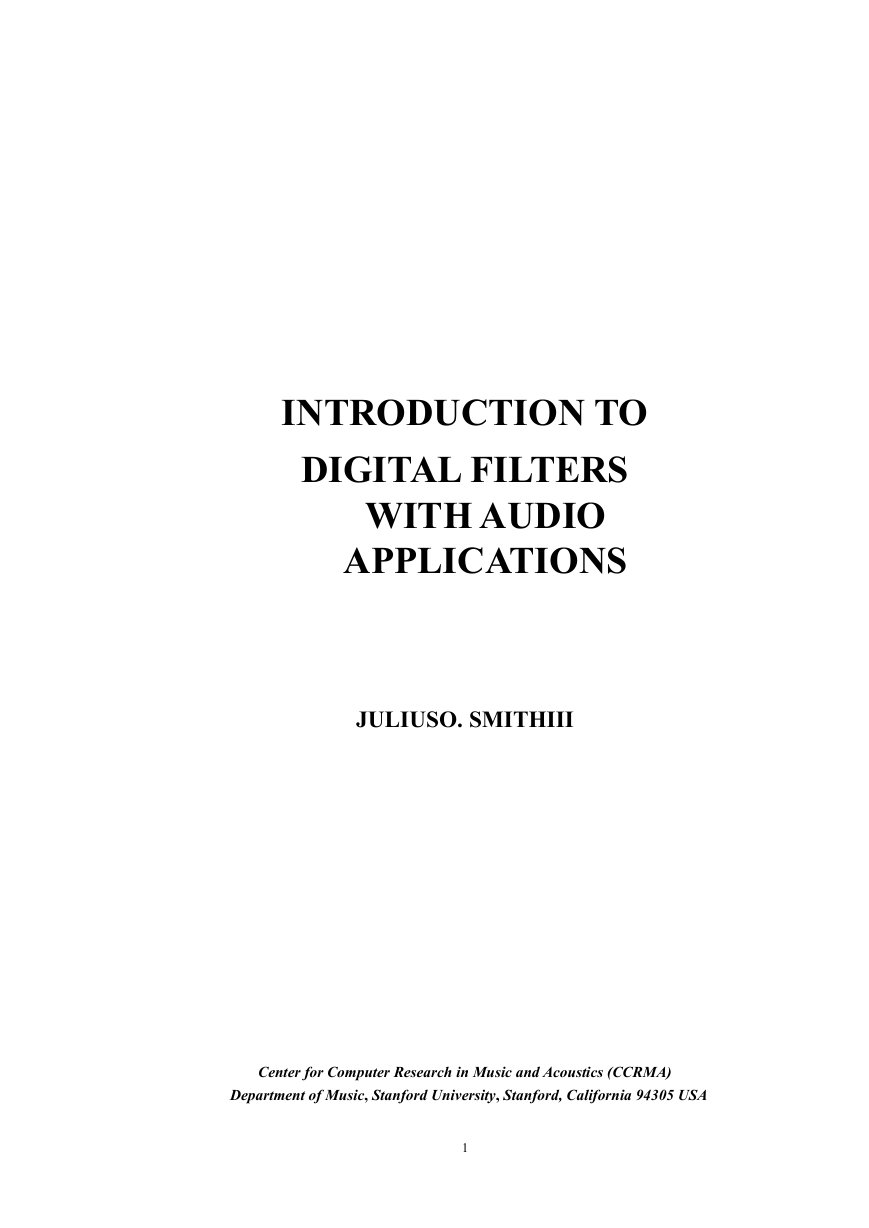

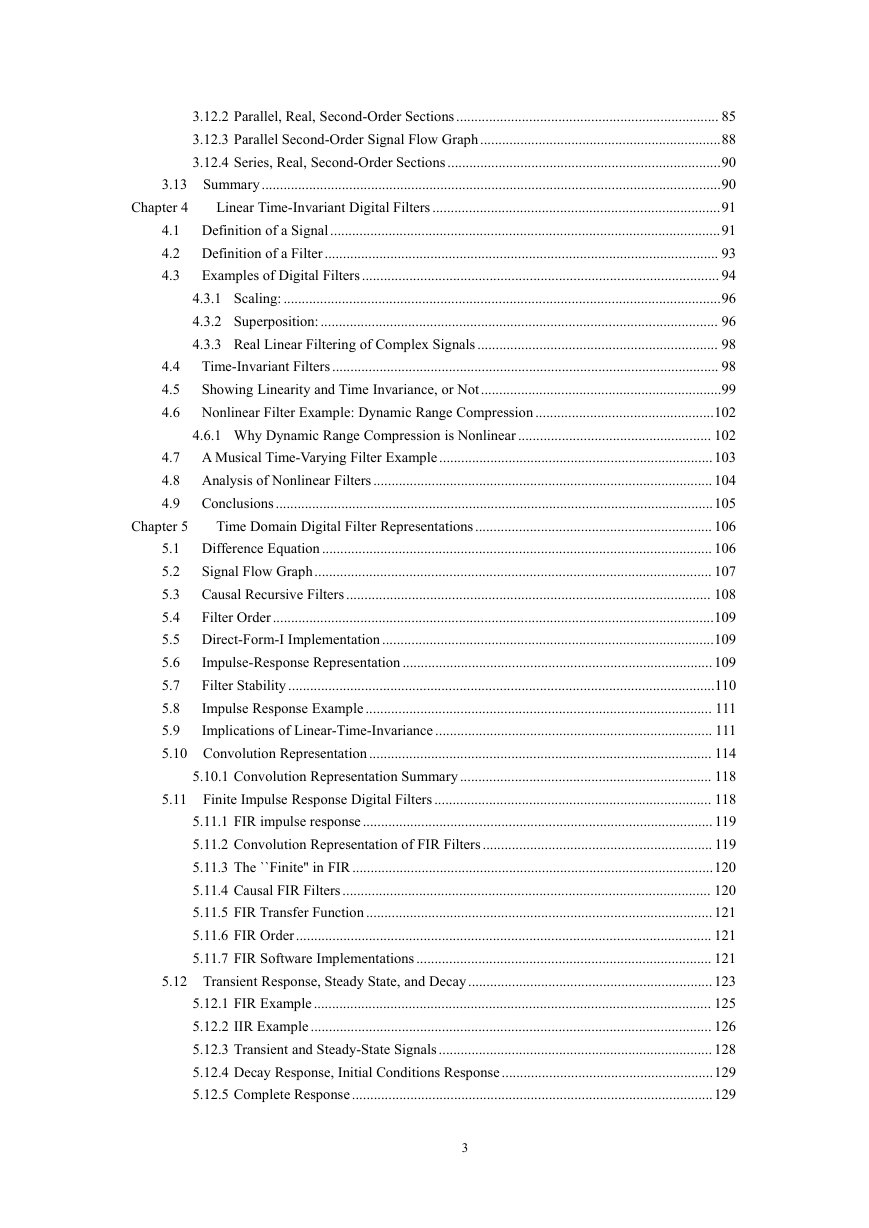
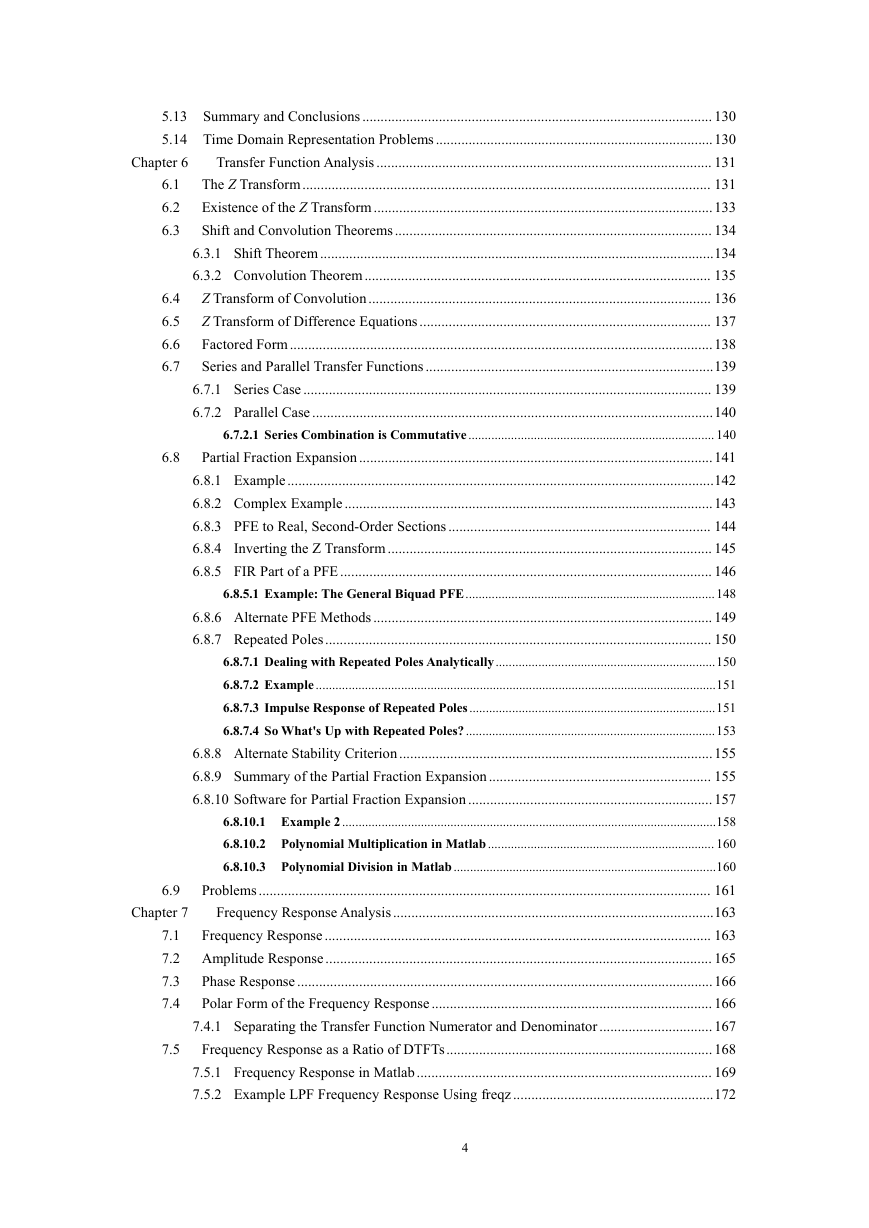


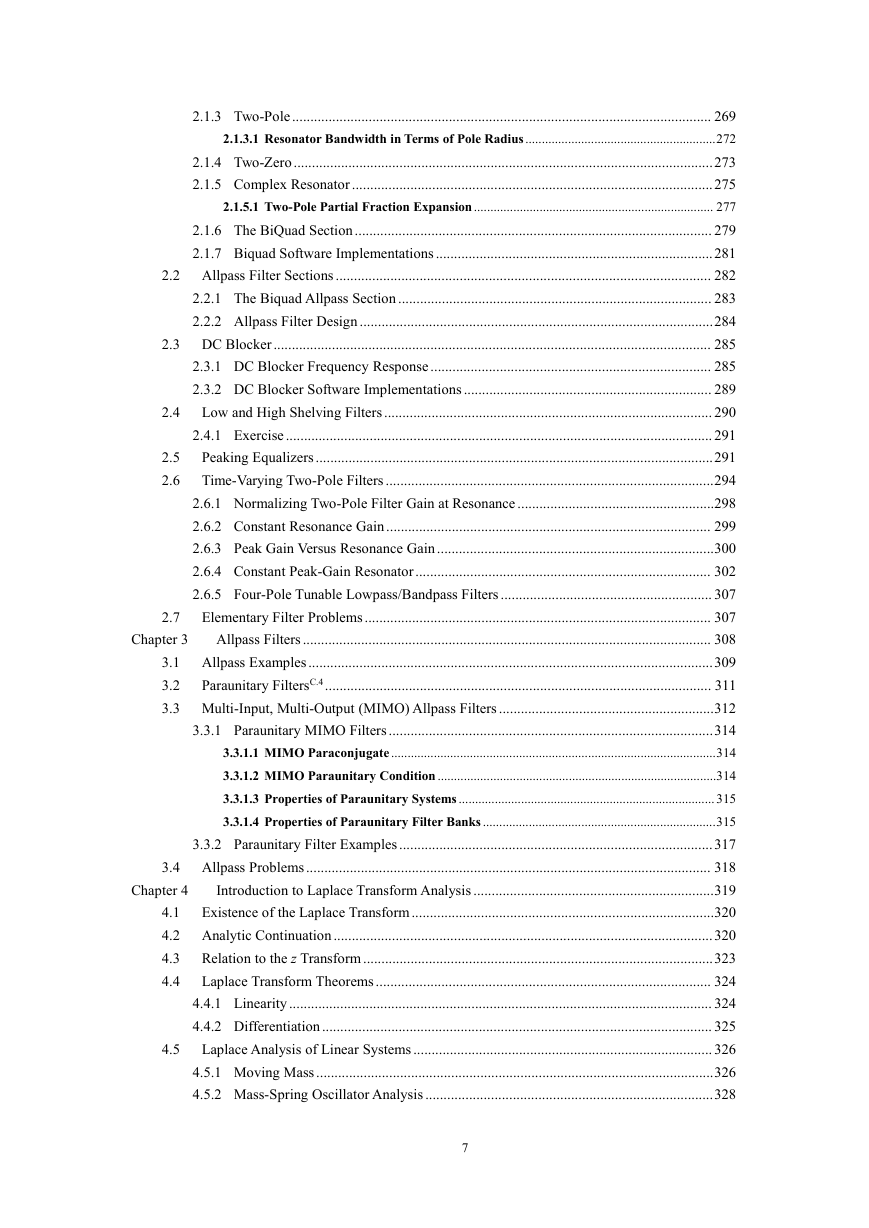
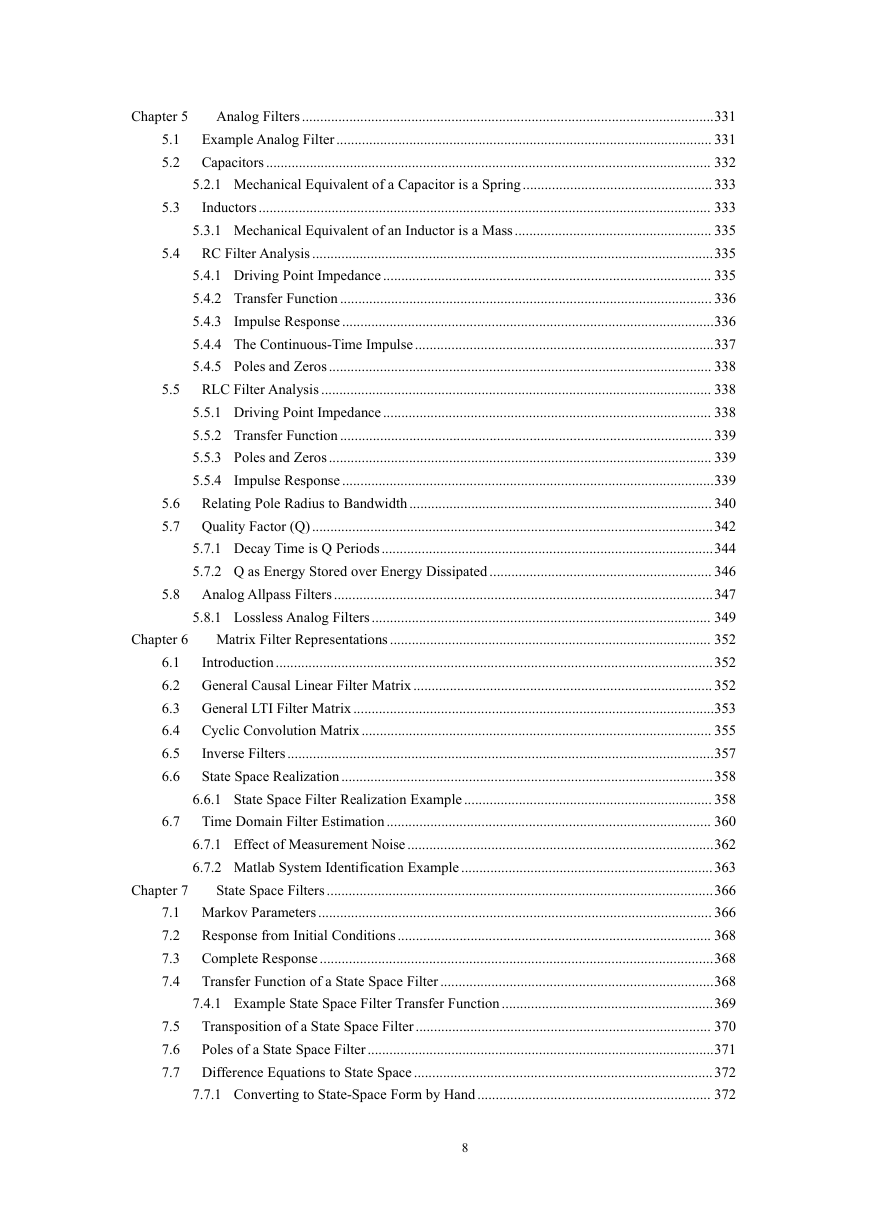








 2023年江西萍乡中考道德与法治真题及答案.doc
2023年江西萍乡中考道德与法治真题及答案.doc 2012年重庆南川中考生物真题及答案.doc
2012年重庆南川中考生物真题及答案.doc 2013年江西师范大学地理学综合及文艺理论基础考研真题.doc
2013年江西师范大学地理学综合及文艺理论基础考研真题.doc 2020年四川甘孜小升初语文真题及答案I卷.doc
2020年四川甘孜小升初语文真题及答案I卷.doc 2020年注册岩土工程师专业基础考试真题及答案.doc
2020年注册岩土工程师专业基础考试真题及答案.doc 2023-2024学年福建省厦门市九年级上学期数学月考试题及答案.doc
2023-2024学年福建省厦门市九年级上学期数学月考试题及答案.doc 2021-2022学年辽宁省沈阳市大东区九年级上学期语文期末试题及答案.doc
2021-2022学年辽宁省沈阳市大东区九年级上学期语文期末试题及答案.doc 2022-2023学年北京东城区初三第一学期物理期末试卷及答案.doc
2022-2023学年北京东城区初三第一学期物理期末试卷及答案.doc 2018上半年江西教师资格初中地理学科知识与教学能力真题及答案.doc
2018上半年江西教师资格初中地理学科知识与教学能力真题及答案.doc 2012年河北国家公务员申论考试真题及答案-省级.doc
2012年河北国家公务员申论考试真题及答案-省级.doc 2020-2021学年江苏省扬州市江都区邵樊片九年级上学期数学第一次质量检测试题及答案.doc
2020-2021学年江苏省扬州市江都区邵樊片九年级上学期数学第一次质量检测试题及答案.doc 2022下半年黑龙江教师资格证中学综合素质真题及答案.doc
2022下半年黑龙江教师资格证中学综合素质真题及答案.doc